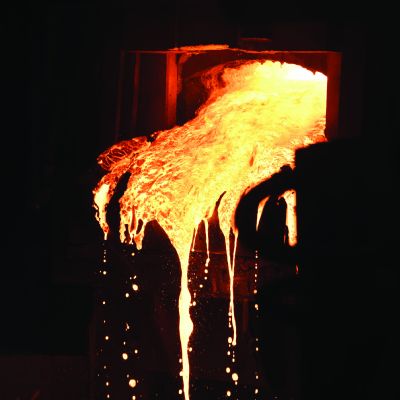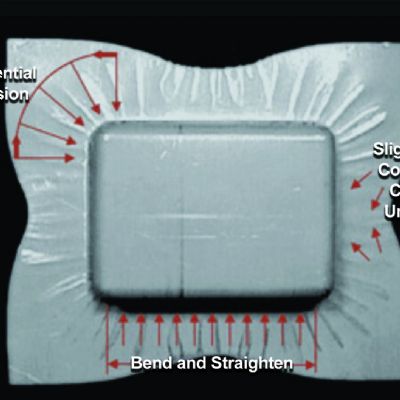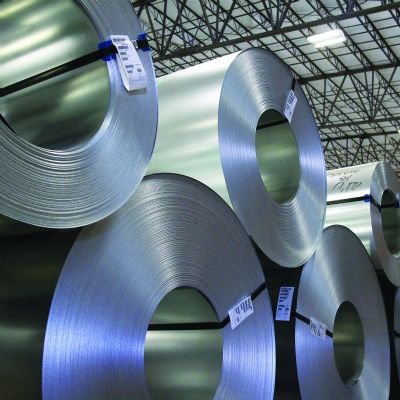2nd Gen steels include twinning induced plasticity (TWIP), as well as austenitic stainless steels, which are highly alloyed with a nearly 100-percent austenitic microstructure as-delivered. Note that the use of 2nd Gen AHSS has been low and continues to diminish over time. Automotive austenitic stainless steels are named based on their yield strength, while the names of TWIP steels reflect their tensile strength.
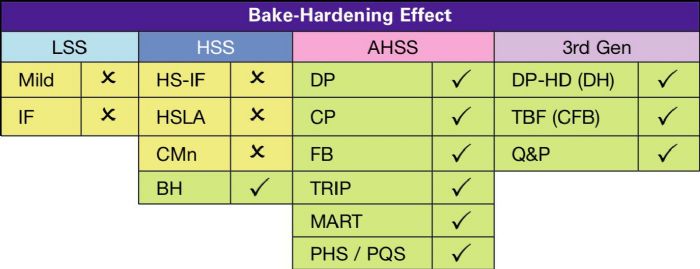 Lastly, 3rd Gen AHSS, still being developed, include TRIP-aided bainitic ferrite (TBF, or carbide-free bainite, CFB), quenching and partitioning (Q & P) steels, dual-phase high-ductility (DP-HD or DH), and complex phase-high ductility (CP-HD or CH). Steelmakers and automotive OEMs use these terms interchangeably. But note: The abbreviation DH was used in the SAE standard for 1st Gen DP steels with high yield strength, so be cautious when referring to these grades.
Lastly, 3rd Gen AHSS, still being developed, include TRIP-aided bainitic ferrite (TBF, or carbide-free bainite, CFB), quenching and partitioning (Q & P) steels, dual-phase high-ductility (DP-HD or DH), and complex phase-high ductility (CP-HD or CH). Steelmakers and automotive OEMs use these terms interchangeably. But note: The abbreviation DH was used in the SAE standard for 1st Gen DP steels with high yield strength, so be cautious when referring to these grades.
Table 1 shows the naming systems for various grades used by automotive OEMs and standards-writing bodies. For example, the generic DP590 steel may be named:
- SAE J2745 DP590T/340Y (where T signifies tensile strength and Y yield strength);
- EN 10338 HCT590X (H signifies high strength, C cold rolled, T tensile strength, X dual phase;
- VDA239-100 CR330Y590T-DP (cold rolled 330-MPa minimum yield, 590-MPa minimum tensile strength, dual phase; or
- JFS A2001 JSC590R (cold rolled, 590-MPa minimum tensile strength, and R signifies dual phase).
590 or 600? 780 or 800? Why?
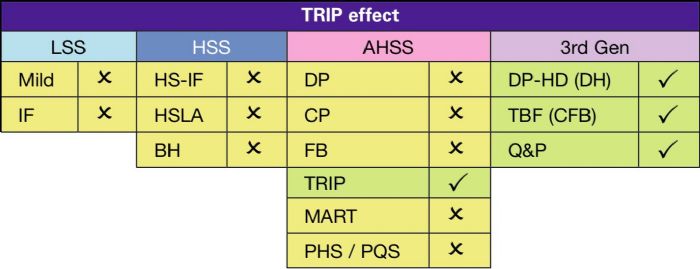 Some people refer to DP590 steels as DP600, and some refer to DP780 as DP800. This rounding occurs because the earlier SAE norm (J2340-1999) referred to strength levels of 600, 800 and 1000 MPa. Now, most steel standards list strength levels as 590, 780, 980 and 1180 MPa. One may argue that DP590 and DP600 are not the same, claiming theoretically that a coil with 595-MPa tensile strength would qualify to be named DP590 but not DP600. Even though some OEMs still use 600, 800 and 1000 in their steel names, on the spec sheet their minimum tensile-strength requirements still are 590, 780 and 980 MPa.
Some people refer to DP590 steels as DP600, and some refer to DP780 as DP800. This rounding occurs because the earlier SAE norm (J2340-1999) referred to strength levels of 600, 800 and 1000 MPa. Now, most steel standards list strength levels as 590, 780, 980 and 1180 MPa. One may argue that DP590 and DP600 are not the same, claiming theoretically that a coil with 595-MPa tensile strength would qualify to be named DP590 but not DP600. Even though some OEMs still use 600, 800 and 1000 in their steel names, on the spec sheet their minimum tensile-strength requirements still are 590, 780 and 980 MPa.
So, in practice it still is correct to use 590, 690, 780, 980 and 1180. They seem arbitrarily chosen, but when divided into the gravity constant (9.81 N/kg) the logic behind these numbers emerges (Table 2). In some parts of Asia, steels are referred to using a number based on kgf/mm2. For example, a TRIP 980 steel may be called 100K TRIP. This is especially confusing for Americans, as it may be understood as 100-ksi TRIP steel, equivalent to TRIP 690.
Steel Equivalency Tables: Avoid Using Them!
Note that for material testing, different standards bodies (SAE, EuroNorm [EN], VDA, JFS or OEMs) may use different specimen types and experimental conditions. Therefore, the total elongation of a European steel-mill certificate may not be comparable to one from the United States (Table 3). Europeans typically use ISO Type II tensile specimens, with 80-mm gauge length and 20-mm specimen width. In the United States, ASTM E8 dictates 50-mm gauge length with 12.5-mm width. And in Japan, JIS specimens call for 50-mm gauge and 25-mm specimen width.
Several global OEMs specify total elongation requirements based on different standards, typically abbreviated as A80 and A50. A80 is used for ISO or EN standards, whereas A50 may be used for JIS and ASTM, using 50-mm gauge length. Since the specimen geometries differ, the total elongation measured from an ASTM specimen may differ from that of a JIS specimen.
Also note in Table 3 that n and r values may be in different directions: 0 deg. means longitudinal to rolling direction while 90 deg. means transverse. rm is the average of all r values:
rm = (r0 + 2r45 + r90)/4
Creating a mill certificate for the steels listed in Table 3 may require different specimen types cut from different directions. To prepare certs for JFS and VDA, the steelmaker would need to perform at least three tests from all directions specified in the equation above—rolling (0 deg.), diagonal (45 deg.) and transverse (90 deg.). Without these required experimental values, you cannot say that an HC180B is equivalent to CR180BH.
VDA239-100 specified tensile testing of HSLA grades in the longitudinal direction, whereas the EuroNorm standard called for testing in the transverse direction. One German steelmaker sells HX340LAD (coated HSLA with minimum 340-MPa yield strength in the transverse direction) in EuroNorm as CR300LA in VDA239-100 (minimum 300-MPa yield strength in the longitudinal direction). Thus, EN 10346 HX340LAD is not equivalent to VDA239-100 CR340LA, as most equivalency spreadsheets claim.
As seen in several examples, I do not advise using the steel-equivalency tables found online, as most of them fail to catch some important details. Rather than “equivalent,” the correct word should be “similar.”
Deciding if a Grade is HSS, AHSS or UHSS
I hear this question regularly. In the past, several steel authorities developed global formability diagrams (commonly known as banana curves), with threshold yield- and/or tensile-strength values for HSS, AHSS and UHSS. This created confusion among users.
Steels typically are classified based on their microstructure and the hardening mechanisms used:
- Conventional HSS are ferritic only and are hardened through solid solution hardening, bake hardening or microalloying (in HSLA).
- 1st Gen AHSS are martensitic and multiphase, and strength-ductility depends on the phase fractions and composition.
- There is no clear consensus on a UHSS definition. Previously, SAE defined DP600 (and yes, it used the 600 designation) as UHSS. Currently, the widely accepted value for UHSS is minimum 980-MPa tensile strength.
Note that the main criterion for a steel to be classified as AHSS is not minimum yield or tensile strength, but the microstructure. For example, in the VDA239-100 standard HR700LA—a ferritic steel with 700-MPa minimum yield and 750-MPa minimum tensile strength—should be classified as HSS. And, CR290Y490T-DP has 290-MPa minimum yield and 490-MPa minimum tensile strength but is classified as AHSS because it is multiphase (ferritic and martensitic).
Bake Hardening and TRIP Effects
Bake-hardening (BH) steels is a baffling name, as most people in the industry and academia believe that only BH steels harden during paint baking after deformation. BH steels (Table 4) are the only grades in the HSS family to exhibit the bake-hardening effect. All AHSS, including Gen 3 steels, have even higher (between 40 and 100 MPa) bake-hardening indexes, compared to BH steels (typically 25 to 40 MPa).
Within the 1st Gen AHSS, retained austenite is only found in TRIP steels. When austenite is deformed, it may transform to martensite. This increases the strain-hardening rate, and thus improves formability. This is called TRIP effect. In 2nd Gen AHSS, austenitic stainless steel can be nearly entirely austenitic. 3rd Gen AHSS also rely on the TRIP effect for improved formability. So far, all commercially available 3rd Gen AHSS have retained austenite and thus the TRIP effect, as shown in Table 5. MF
Industry-Related Terms: Austenite,
Austenitic Stainless Steel,
Die,
Draw,
Ductility,
Ferritic,
Form,
Forming,
Gauge,
Martensite,
Quenching,
Stainless Steel,
Tensile StrengthView Glossary of Metalforming Terms
See also: Billur Metal Form
Technologies: Materials
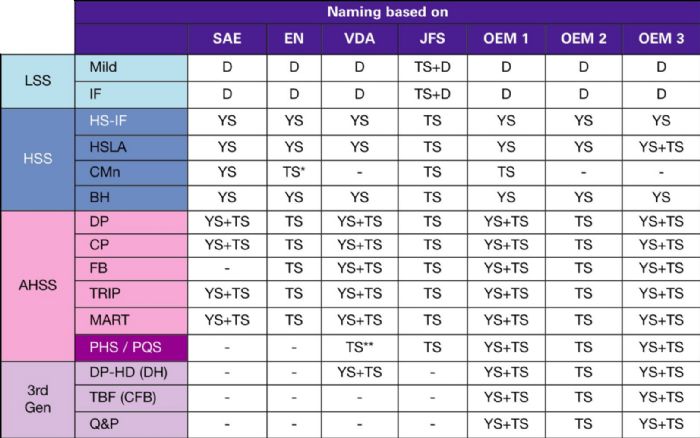 Stampers readily form and deep draw lower-strength steels (low-carbon mild steels as well as interstitial-free (IF) grades). These steels often are named based on their drawability, a combination of r and n values and total elongation. Recently, these steels have taken on the names CR1 to CR6 by SAE, VDA and several OEMs. The higher the number the better the formability. In Europe, examples of these grades DC01 to DC07 and FeP1 to FeP6, and in Japan their names are based on their minimum tensile strength (260 or 270 MPa) and their drawability—referred to with a letter, JSC270C being the least formable and JSC260G being the most (Table 1).
Stampers readily form and deep draw lower-strength steels (low-carbon mild steels as well as interstitial-free (IF) grades). These steels often are named based on their drawability, a combination of r and n values and total elongation. Recently, these steels have taken on the names CR1 to CR6 by SAE, VDA and several OEMs. The higher the number the better the formability. In Europe, examples of these grades DC01 to DC07 and FeP1 to FeP6, and in Japan their names are based on their minimum tensile strength (260 or 270 MPa) and their drawability—referred to with a letter, JSC270C being the least formable and JSC260G being the most (Table 1). 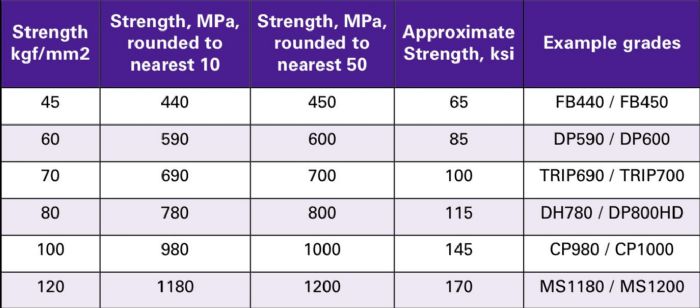 Conventional high-strength steels (HSS) include high-strength IF grades (HS-IF), bake-hardenable (BH), solid solution hardened (CMn or rephosphorized) and high-strength low-alloy (HSLA) steels. In Europe and North America, most HSS (except for CMn) are named after yield strength, while in Japan steels are named based on tensile strength. This may be confusing, as JSC340H is similar to HC180B or SAE 180B (Table 3). All of these steels could be generically named BH180.
Conventional high-strength steels (HSS) include high-strength IF grades (HS-IF), bake-hardenable (BH), solid solution hardened (CMn or rephosphorized) and high-strength low-alloy (HSLA) steels. In Europe and North America, most HSS (except for CMn) are named after yield strength, while in Japan steels are named based on tensile strength. This may be confusing, as JSC340H is similar to HC180B or SAE 180B (Table 3). All of these steels could be generically named BH180. 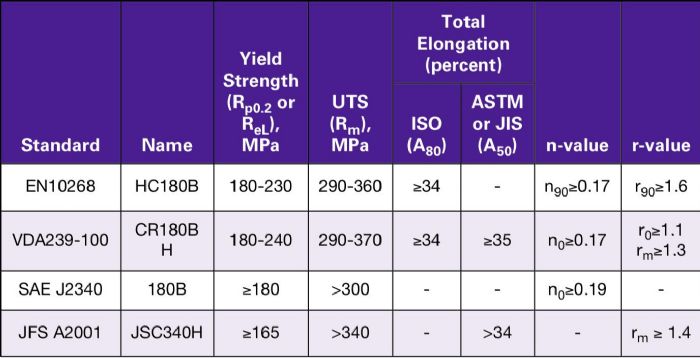 Martensitic and multiphase steels having a minimum specified tensile strength of at least 440 MPa.
Martensitic and multiphase steels having a minimum specified tensile strength of at least 440 MPa. 






 Lastly, 3rd Gen AHSS, still being developed, include TRIP-aided bainitic ferrite (TBF, or carbide-free bainite, CFB), quenching and partitioning (Q & P) steels, dual-phase high-ductility (DP-HD or DH), and complex phase-high ductility (CP-HD or CH). Steelmakers and automotive OEMs use these terms interchangeably. But note: The abbreviation DH was used in the SAE standard for 1st Gen DP steels with high yield strength, so be cautious when referring to these grades.
Lastly, 3rd Gen AHSS, still being developed, include TRIP-aided bainitic ferrite (TBF, or carbide-free bainite, CFB), quenching and partitioning (Q & P) steels, dual-phase high-ductility (DP-HD or DH), and complex phase-high ductility (CP-HD or CH). Steelmakers and automotive OEMs use these terms interchangeably. But note: The abbreviation DH was used in the SAE standard for 1st Gen DP steels with high yield strength, so be cautious when referring to these grades. Some people refer to DP590 steels as DP600, and some refer to DP780 as DP800. This rounding occurs because the earlier SAE norm (J2340-1999) referred to strength levels of 600, 800 and 1000 MPa. Now, most steel standards list strength levels as 590, 780, 980 and 1180 MPa. One may argue that DP590 and DP600 are not the same, claiming theoretically that a coil with 595-MPa tensile strength would qualify to be named DP590 but not DP600. Even though some OEMs still use 600, 800 and 1000 in their steel names, on the spec sheet their minimum tensile-strength requirements still are 590, 780 and 980 MPa.
Some people refer to DP590 steels as DP600, and some refer to DP780 as DP800. This rounding occurs because the earlier SAE norm (J2340-1999) referred to strength levels of 600, 800 and 1000 MPa. Now, most steel standards list strength levels as 590, 780, 980 and 1180 MPa. One may argue that DP590 and DP600 are not the same, claiming theoretically that a coil with 595-MPa tensile strength would qualify to be named DP590 but not DP600. Even though some OEMs still use 600, 800 and 1000 in their steel names, on the spec sheet their minimum tensile-strength requirements still are 590, 780 and 980 MPa. 